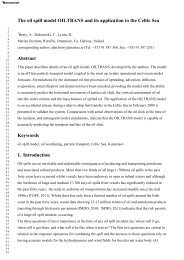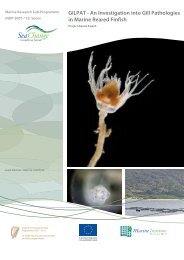Marine Industries Global Market Analysis - Marine Institute
Marine Industries Global Market Analysis - Marine Institute
Marine Industries Global Market Analysis - Marine Institute
You also want an ePaper? Increase the reach of your titles
YUMPU automatically turns print PDFs into web optimized ePapers that Google loves.
MARINE INDUSTRIES GLOBAL MARKET ANALYSIS<br />
101<br />
18 <strong>Marine</strong> Renewable Energy<br />
1999–03 2004 2005–09<br />
Irish <strong>Market</strong> €M 46 – 255<br />
UK <strong>Market</strong> €M 108 109 3,356<br />
Europe <strong>Market</strong> €M 738 121 11103<br />
World <strong>Market</strong> €M 741 128 12,649<br />
Definition – total capital expenditure on wind, wave and tidal current installations.<br />
18.1 INTRODUCTION<br />
This sector is made up of expenditure on wind, wave and tidal installations.<br />
Currently a very small industry, the forecast for growth is huge.<br />
Figure 18.1: <strong>Marine</strong> Renewable Energy –<br />
World <strong>Market</strong><br />
18.2 WORLD MARKET<br />
Investment in offshore renewable energy is now growing strongly, but from a very<br />
small base. From €128 million capital investment in 2004, expenditure is expected to<br />
exceed €5.6 billion by 2009, plus operating expenditure. Some 85% of forecast<br />
expenditure in the period 2005 to 2009 is expected to be in Western Europe with<br />
North America forming the second largest segment at 12%.<br />
The main market driver is the political response to global warming.The UK, for<br />
example, wants to generate 10% of its electricity from renewables by 2010 and 20%<br />
by 2020.The most obvious solution is to increase the use of windpower. However,<br />
the best European onshore locations are becoming used up, there are considerable<br />
local objections to the visual impact of wind turbines and the best (windiest) sites<br />
often have no nearby access to the main transmission grid.<br />
The industry is therefore beginning to move offshore where turbines are out of<br />
sight and have a better wind environment.There have been relatively few installations<br />
to date but major growth is forecast.We are at the beginnings of an important<br />
new industry.<br />
The other developing technologies are wave and tidal current power.These are<br />
at a much earlier stage of commercial take-up and are forecast to form only 1% of<br />
the capital investment in offshore renewable energy by 2009. However, they have<br />
considerable long-term potential<br />
18.3 EUROPEAN MARKET<br />
Over the next five years, Douglas-Westwood forecast that Western Europe will<br />
account for 88% of global expenditure on marine renewable energy. Under present<br />
plans, Ireland would continue to be a very small producer with its share reducing due<br />
to strong growth in other countries’ activities. However, the country’s potential as a<br />
location for offshore renewable energy projects is considerable.<br />
Source: Douglas–Westwood<br />
Table 18.1: <strong>Marine</strong> Renewable Energy – Totals<br />
1999–03 2004 2005–09<br />
Africa 0 0 0<br />
Asia 1 0 20<br />
Australasia 0 0 6<br />
E Europe/FSU 0 0 50<br />
Latin America 0 0 0<br />
Middle East 0 0 0<br />
North America 2 7 1470<br />
Western Europe 738 121 11103<br />
TOTAL ($M) 741 128 12649<br />
Source: Douglas-Westwood<br />
Figure 18.2: <strong>Marine</strong> Renewable Energy –<br />
Regional Segmentation 2005–2009<br />
Source: Douglas–Westwood

















